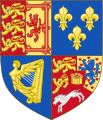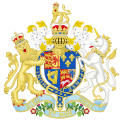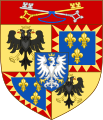House of Este
Casa d'Este
Estensi
From the town of Este
1097
Ercole III (Modena)
Maria Beatrice (Massa & Carrara)
- Marquis of Este
(1097–1463) - Marquis of Ferrara
(1208–1471) - Duke of Ferrara
(1471–1598) - Duke of Modena and Reggio
(1452–1803) - Duke of Massa and Prince of Carrara
(1790–1829) - Duke of Breisgau
(1801–1805)
Castello Estense (Ferrara)
Ducal Palace (Modena)
- Palazzo dei Diamanti (Ferrara)
- Palazzo Paradiso (Ferrara)
- Palazzo Schifanoia (Ferrara)
- Palazzina Marfisa d’Este (Ferrara)
- Ducal Palace (Sassuolo)
- Rocca Estense (St. Felice sul Panaro)
- Delizia di Belriguardo (Voghiera)
- Palazzo Estense (Varese)
- Villa d'Este (Cernobbio)
- Villa d'Este (Tivoli)
- Castello del Catajo (Padua)
- Palais Modena (Vienna)
1829
House of Welf (elder branch of the original House of Este)
The original House of Este's elder branch, which is known as the House of Welf, included dukes of Bavaria and of Brunswick. This branch produced Britain's Hanoverian monarchs, as well as one Emperor of Russia (Ivan VI) and one Holy Roman Emperor (Otto IV).
The original House of Este's younger branch, which is simply called the House of Este, included rulers of Ferrara (1240–1597), and of Modena (–1859) and Reggio (1288–1796).[10] This branch's male line became extinct with the death of Ercole III in 1803.
According to Edward Gibbon, the family originated from the Roman Attii family, which migrated from Rome to Este[11] to defend Italy against the Ostrogoths. However, there is little evidence to support this hypothesis. The names of the early members of the family indicate that a Frankish origin is much more likely. The Encyclopædia Britannica regards this family as a branch of the Obertenghi.[1][2]
The first known member of the house was Margrave Adalbert of Mainz, known only as the father of Oberto I, Count palatine of Italy, who died around 975. Oberto's grandson, Albert Azzo II, Margrave of Milan (996–1097) built a castle at Este, near Padua, and named himself after the location. He had three sons from two marriages, two of whom became the ancestors of the two branches of the family:
The two surviving branches, with Duke Henry the Lion of Saxony and Bavaria on the German (Welf dynasty) side, concluded an agreement in 1154 which allocated the family's Italian possessions to the younger line, the Fulc-Este, who in the course of time acquired Ferrara, Modena and Reggio. Este itself was taken over in 1275 by Padua, and in 1405 (together with Padua) by Venice.
The elder branch of the original House of Este, known as the House of Welf (were also called Guelfs "Guelf" or "Guelph" which derives from the Italianized name for original “Welf”), produced dukes of Bavaria (1070–1139, 1156–1180), dukes of Saxony (1138–1139, 1142–1180), a Holy Roman Emperor, Otto IV (1198–1218), dukes of Brunswick and Lüneburg (1208–1806), later also dukes of Saxe-Lauenburg (1689-1803), styled the "Electors of Hanover" in 1705, and princes of Brunswick-Wolfenbüttel (1269-1807). The House of Welf gave Great Britain and the United Kingdom the "Hanoverian monarchs" (1714–1901) as well as gave Russia an emperor Ivan VI.
After the peace ending the Napoleonic Wars reshaped Europe, ushering in the modern era, the Electorate of Hanover (duchy of Brunswick and Lüneburg, held in personal union by the king of Great Britain, George III) was dissolved by treaty. Its lands were enlarged and the state was promoted to a kingdom. The new kingdom existed from 1815 to 1866, but upon the accession of Queen Victoria (who could not inherit Hanover under Salic law) in 1837, it passed to her uncle, Ernest Augustus, King of Hanover, and thus ceased to be in personal union with the British Crown.
The senior branch of the House of Welf continued to be ruled by the princes of Brunswick-Wolfenbüttel, as undisputed until the death of the ruling duke of Brunswick Prince William VIII, in 1884. Prior to his death, his brother Charles II from Geneva, as exiled de jure ruler of the house, had declared the Prussian annexation of the crown and the earlier Hanoverian usurpation absolutely illegal acts of usurpation inside of the German House. At his death, his grandson continued internationally recognized appeals. Hanover formed the Guelph Party (or German Party) to continue political appeals against the Prussian and German annexations of the crown.
















